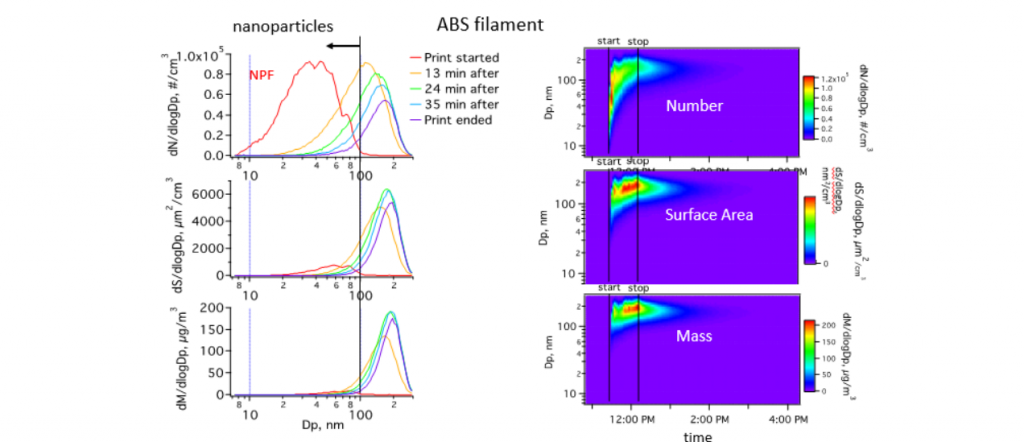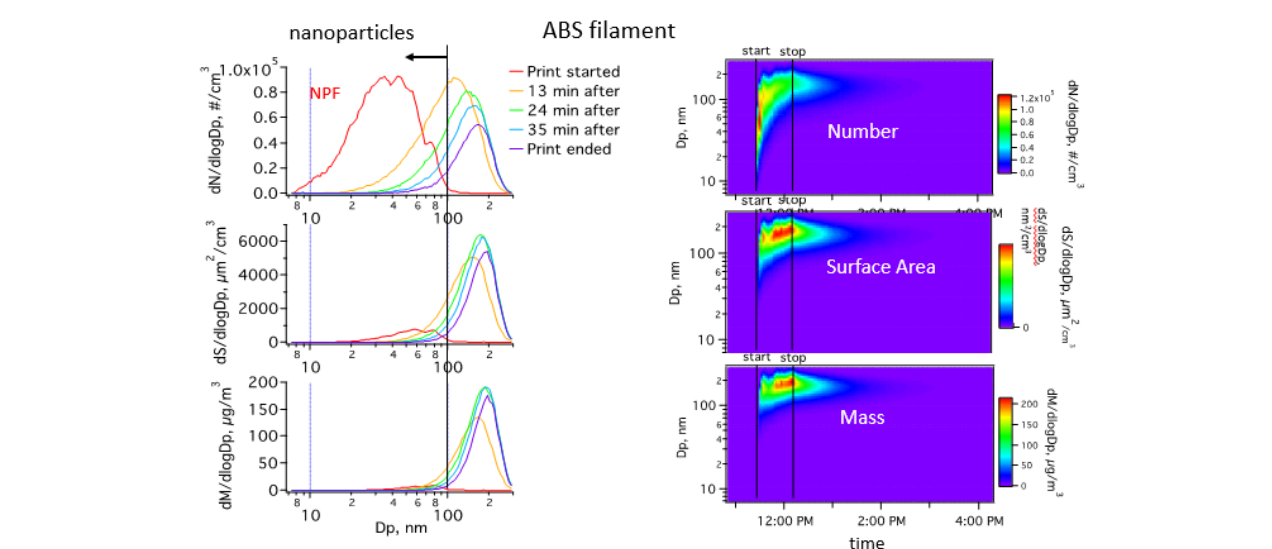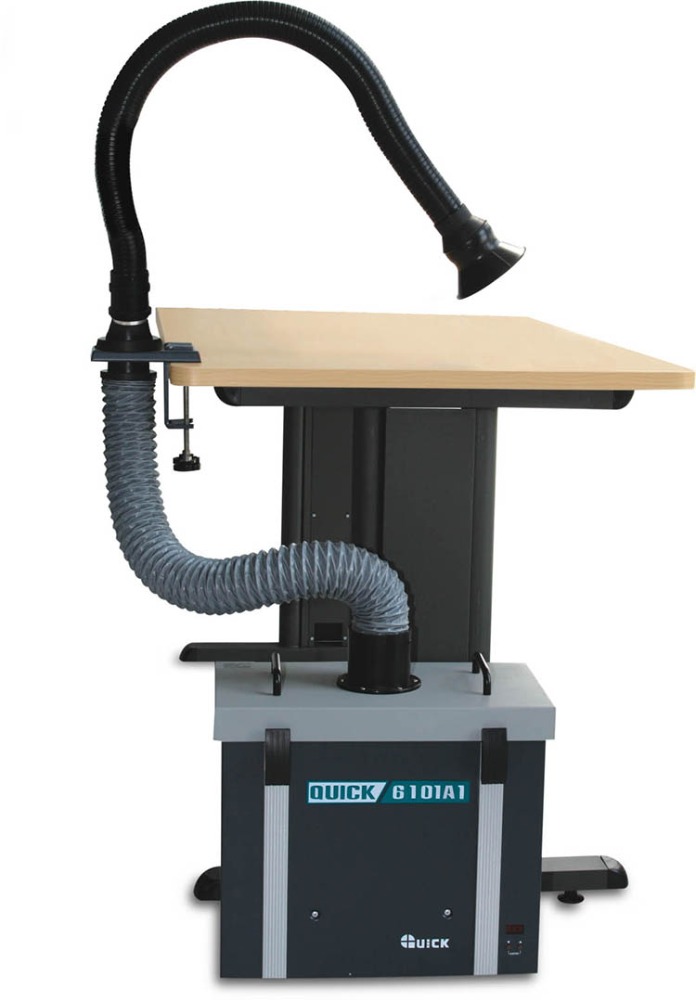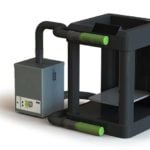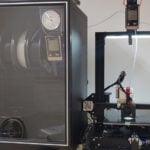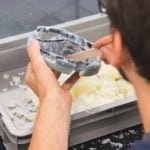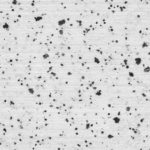Table of Contents
Particle Size and Composition of 3D Printing Fumes
3D printers are known to produce a number of byproducts during operation. Common 3D printing filaments such as ABS and PLA are known as high emitters of ultra-fine particulates (UFPs), while nylon and PCTPE are known for high levels of volatile organic compounds (VOC) concentrations. Once airborne, particles and noxious fumes are easily absorbed into lungs where they can enter tissues and cells.
In this post, we’ll define the parameters that influence dispersion and solutions for eliminating 3D printing toxins, odors, and fumes.
Ultrafine Particles (UFPs) in 3D Printing Fumes
Particles smaller than 100nm are referred to as ultra-fine particles (UFPs). Because these particles are so small, standard air filters and even HEPA filtration may not be sufficient in capturing and retaining all particles. UFPs become airborne more easily because of their small size. While large particles generally settle quickly, UFPs are able to transverse large areas of space. Greater buoyancy allows airborne suspension for long periods of time, sometimes up to 48 hours.
3D printing fumes include VOC’s such as carbon monoxide, caprolactam, styrene, lactide and hydrogen cyanide.

How Harmful Are 3D Printing Fumes?
The risk of harm from 3D printing particulates and gases require context. According to this study by the International Journal of Environmental Research and Public Health, the extent of health risks from PLA emissions is comparable to that of cooking with an electric frying pan. For ABS plastics, emissions register an order of magnitude lower than cooking with gas or electric stoves on high.
A traditional Indian chicken and rice meal (62-minute cook time/ 113,000 UFPs/cm3), or American fried chicken meal (11-minute cook time/173,000 UFPs/cm3) creates notably more ultrafine particles than the most noxious 3D printing filaments. Over a 1-hour period, ABS tops out at ~80,000 UFPs/cm3, about 12x less than the fried chicken over the same time period. The difference between the two is that 3D printing cycles could remain in motion 24/7.
Distance from the printer must also be considered. When establishing thresholds for aerosol particles, particles tend to settle or stick to surfaces as they work across a room. Methods of transfer include foot-traffic, physical agitation, or air currents. Therefore, depending on print temperature, print complexity, and environmental factors, harm reduction must be evaluated more closely.
In environments with a single 3D printer that is segregated from common workspaces, the risk of fumes from a 3D may are less significant but should be carefully considered. In environments with multiple 3D printers or parallel workspaces, the potential health impacts and methods of harm reduction must be critically considered. To assess the impact and dispersion of 3D printing particulates, we’ll reference this study.
“The most effective control strategies for reducing both UFP and VOC concentrations included installing a high-flow spot ventilation system and operating the printer in a sealed enclosure with high-efficiency gas and particle filtration.”
Efficacy of HEPA Filtration and Other Methods for Capture of 3D Printing Fumes
The capture of particles by fume extraction or retainment systems ranges between 2% and 95%+. Filter design is important based on the size and characterization of a particle. UFPs and VOCs require different filters. HEPA filters are 0% effective for gaseous chemical compounds such as Formaldehyde, Ozone, Carbon Monoxide, Carbon Dioxide, Sulphur and Nitrous Oxides.
Filtration efficacy differs based on the number of printers, air currents, filter location, print complexity, use of an enclosure, and air currents. The most ideal option is a fume extraction unit that contains both carbon and HEPA filtration media. An activated carbon filter is capable of filtering odors and gaseous artifacts, while a HEPA filter captures other remnants of the additive process.
Do HEPA Filters Work for 3D Printing Fumes?
A HEPA filter (high-efficiency particulate absorber) is a type of air filter with small membranes that capture small pollutants and particles. The filter medium consists of microporous polyurethane minipleats. Particles passing through the air stream are intercepted and retained by curves and contours in the filter with increasing efficiency as air velocity increases.
HEPA filters are rated effective at 0.3 µm, but may be effective in capturing particles as small as 0.1 µm. The Brownian motion describes the random and erratic nature of the smallest particles. Particles often clump, cluster, and zigzag erratically which increases the probability to impact the filter fibers. HEPA filters extend protection from particulates like dust, macro debris, allergens, and remnants from the filament manufacturing process.
It’s important to note that particles less than 0.1 µm are captured more efficiently than particles between 0.1 – 0.4 µm. That’s because the smallest particles are most affected by diffusion, which is a benefit of using a HEPA filter to curb UFP emissions.
What is a Carbon Filter? How does it work for filtering 3D printing fumes?
Activated carbon filters, also known as activated charcoal are used for purification of gas, water, metal extraction, pharmaceutical manufacturing, and air respirators. The carbon is extremely porous which extends its inter-particulate surface area. This design is associated with many favorable outcomes including filtration, purification, deodorization, de-colorization, and separation. When applied to 3D printing, it removes commonly produced odors associated with 3D printing filaments such as ABS. It also removes parallel gases such as formaldehyde, ozone, carbon monoxide, carbon dioxide, sulfur and nitrous oxides.
Flow Rate for 3D Printing Air Filtration
While a 3D printing enclosure is the most effective method of stifling ULP’s, without an air tight seal the the printing will continue to emit gases, especially once opened. Likewise, removing the print from the tray and opening the enclosure will agitate particles that have settled within the enclosure and cause them to become airborne. This is why it’s recommended that filtration include a combination of an enclosure and filtration system, or a dedicated spot ventilation system with an effective air flow rate.
Determining Effective Flow Rates for 3D Printing Fume (Spot) Filters
In the study we mentioned above, researchers outline a number of solutions that drastically curb 3D printing emissions to safe levels. The best option varies depending on the type of materials in use, air flow conditions, proximity, and personal preference. They noted that one of the most effective pollution controls was a spot filtration system that ranged between a “medium” and “high” flow rate
We reached out to the authors of the study from the Illinois Institute of Technology to clarify what flow rate was defined as low-volume air flow, medium air flow, and high-flow air extraction.
When referencing airflow volumes of 3D printing fume extractors:
"For the purposes of our study, we defined them somewhat arbitrarily, specifically: our two air cleaner scenarios were 100 m3/h and 300 m3/h clean air delivery rates (i.e., airflow rate times removal efficiency), and for spot ventilation we chose 90, 360, and 1800 m3/h (i.e. ~52, ~212, and ~1060 CFM). These values are described in SI units in the text. Clearly, 1000+ CFM is quite extreme, and thus represents a very high volume spot ventilation system."
Researcher, PhD - Illinois Institute of Technology
Low-Flow Spot Filters (50 - 90 CFM)
Low-volume spot filters are least effective in removing particle and gas contaminants for 3D printing. To create the proper negative pressure across the dimension of the 3D printer and surrounding area, an air flow system must have enough power to extract particles as gases at the point of introduction.
Medium-Flow Spot Filters (150 - 350 CFM)
Portable filtration units for 3D printers provide a compact and economical solution for filtering 3D printing fumes. A multi-stage filter curbs both micro and macroparticles. The pre-filter prevents extra large particles from impacting the HEPA filter which increases filter life and performance.
High Flow Filters (500 - 1,000+ CFM)
High flow fan filter units are common in cleanrooms used for pharmaceutical and electronics manufacturing. A dedicated air recirculation system is often unnecessary for small operations, but perfect for small to medium size laboratories, schools, and other advanced manufacturing labs with inadequate or outdated ventilation systems.
Portable Fume Extractors for 3D Printers
There are a number of advantages to a multi-stage fume extraction for 3D printing. HEPA filtration allows the retention of 99.9% of particles larger than 0.3 micron. The final stage is an activated carbon design which chemically nullifies VOCs and other gaseous contaminants.
One reason we recommend Quick’s multi-stage filter extractor is because each stage of the filter is independently replaceable. Detachable filters lower the overall cost of ownership. A pre-filter will require replacement most often, but are very affordable. The HEPA and carbon media are replaced after roughly 2,000 hours of use.
The hose systems allows for a fully ventilated system which can be directed out of a window. Most importantly, the internal filter system recycles air directly and then recycles the air into the room after it has been filtered of particles and noxious gases.
Multi-Stage Carbon Activated and HEPA Filtration for 3D Printing
The Quick fume extractor has a low noise profile, about the equivalent of a standard refrigerator. It’s available in a single or dual-nozzle design that allows dual placement on a single printer or provides adaptation for multiple 3D printers on a single workstation or desk.
Related Posts
-
BOFA Fume Extractors for 3D Printing
3D printers are known to produce a number of byproducts during operation. Common 3D printing filaments such as ABS and PLA are known as high emitters of ultra-fine particulates (UFPs), while nylon and PCTPE are…
-
Filament Storage Cabinets for 3D Printing
Notably, filaments such as nylon may absorb unacceptable amounts of water in the short period of time they are on the printer. This cabinet provides active feedports for use during prints, and long term storage…
-
Filament Storage, Dry Boxes and Spool Cabinets for 3D Printing
Are you ruining your 3D printing filaments by baking them? What's the best way to dry FDM and PLA filaments? What about Nylon and PLA?
-
Sterile 3D Printing Materials for Medical Devices
Is sterile 3D printing possible? Are 3D printed parts sterile? This comprehensive guide to 3D printing sterile parts provides materials that withstand various sterilization techniques such as autoclaving, heat, ETO, and gamma. Here's how 3D…
-
How to Remove 3D Printing Support Material Faster and Improve Final Quality
What's the easiest and fastest way to clean 3D printed parts with soluble support materials or standard support materials like HIPS and PVA? Here's how to clean the reaches of 3D printed parts including small…
-
Particulate Matter - What is it and what are the health effects?
Historically, air quality has shown a complex relation to respiratory issues, birth defects, chronic illness, cancer, and even loss of cognitive function. Research suggests air pollution affects everything from neurodevelopment in-utero to cognitive decline in…


